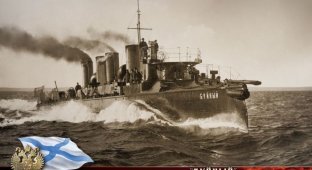The whole history of diving, in photographs (33 photos)
Diving suit - from Leonardo da Vinci to the present day.

Leonardo da Vinci's diving suit, recreated according to his drawings in our time
The diving suit was invented by Leonardo for the Venetians, who constantly had to repel naval military attacks. Leonardo's diving suit was made of leather, the helmet was equipped with glass lenses, and the diver's shoes were weighted with a metal weight. A person in such a suit could breathe with the help of a bell with air lowered under water, from which breathing tubes were connected to the diver's helmet.
The scientist proposed the concept of a diving suit to repel the threat posed by the Turkish fleet. According to the idea, the divers were supposed to dive to the bottom and wait for the arrival of enemy ships. When enemy ships appeared above the water, the divers had to commit sabotage and send the ships to the bottom. It was not destined to prove the correctness of this concept. Venice was able to resist the Turkish fleet without the help of saboteurs.

The first device for diving to great depths of the English royal astronomer, geophysicist, mathematician, meteorologist, physicist and demographer Edmund Halley, late 17th century
English astronomer Edmond Halley (the same Halley who predicted the return of Halley's Comet) built a diving bell, ventilated using barrels of compressed air sent from the surface. Oddly enough, the idea turned out to be successful, and Halley himself and four workers spent over 11 hours at a depth of about 9 fathoms. Ventilation of a diving bell using a pump was first achieved in 1788 by Smeaton, and from that moment on, divers staying under water for many hours ceased to be an extraordinary event.

“The bell sank to the bottom. Then the assistant put another, small bell on his head, and was able to walk a little along the bottom - as far as the tube through which he breathed the air remaining in the large bell allowed him. After that, weighted barrels with an additional supply of air were dropped from above cargo. The assistant found them and dragged them to the bell."

Russia. "Divers don't go into the water without wine"
The professional class of divers in Russia appeared at the beginning of the 17th century along with the development of fishing on the Volga and at the mouth of the Yaik (Ural). It was then, by the way, that the term “diver” itself appeared. Divers were engaged in maintaining state and monastery uchugs (underwater pile barriers into which fish were driven) in working order.
Elder Irinarcha from the Spaso-Prilutsky Monastery at the bend of the Vologda River in January 1606 noted: “He gave Elder Yakim Luzora nine altyns for diving and for pots.” And in 1675, Patriarch Joachim complained to Tsar Alexei Mikhailovich: “But it is impossible for some to do business in their fishing industry without wine, because divers do not climb into the water without wine to fortify fishing faces and wash water and holes, and that’s why their foreign business in Astrakhan The providence of the repairman is causing great chaos and great chaos and much disorder."
Divers were busy catching river pearls, as well as constructing and maintaining hydraulic structures in the Lower Volga fisheries. They dived without using any special equipment, “diving,” and could not perform serious work underwater.
In 1763, the first rules of the diving service were issued in St. Petersburg: “News about the order that must be observed when diving and pulling goods out of the water.”
Diving suit of the French aristocrat Pierre Remy de Beauvais, 1715

One of the two hoses extended to the surface—breathing air flowed through it; the other served to remove exhaled air.

John Lethbridge's diving apparatus, 1715

Sealed oak barrel
This barrel was intended to raise valuables from sunken ships.
In the same year, the Englishman Andrew Becker developed a similar system, which was equipped with a system of tubes for inhalation and exhalation.

Diving apparatus by Karl Klingert, 1797
In 1797, the German A. Klingert proposed the first “clothing for divers”, in which it was actually possible to work under water for more than three minutes. It consisted of a waterproof fabric on the diver's shoulders, attached to the edge of a metal cap that covered the diver's head. A spiral spring was embedded inside two leather breathing pipes with a distribution valve for inhalation and exhalation so that the walls would not be flattened by water pressure.
A pump for ventilation of the suit was not provided because it was assumed that the diver would be able to breathe in the water on his own. In 1798, Klingert's invention was tested on the Oder River near Wraclav. Even with a slight dive, the diver had difficulty breathing, and at a depth of 6 feet it became impossible to breathe, due to the fact that the water pressure on the diver’s chest exceeded the strength of the respiratory muscles.
Subsequently, Klingert improved his costume, giving it a completely monstrous look. To counteract the pressure of water on the diver's chest, Klingert turned the apparatus into a metal cuirass with trousers attached to it. Since the tightness of this structure was questionable, a pump was attached to the cuirass to pump out water entering the apparatus.

"It consisted of a jacket, waterproof leather pants and a helmet with a porthole. The helmet was connected to a turret in which there was a reservoir with an air supply. The reservoir was not replenished, so the time spent under water was limited."

Costume of Chauncey Hall, 1810

The first deep-sea diving suit with heavy boots, August Siebe (Germany), 1819
The inconvenience was that the diver had to maintain a vertical position, otherwise water could get under the bell. In 1937, a waterproof vestment was added to the bell, allowing the diver to become more mobile.

Rookeroille-Deneyrouz equipment model 1865
... "Using the Rookeroille-Deneyrouz device, invented by your compatriot and improved by me, you can immerse yourself in an environment with completely different physiological conditions without any damage to your health. This device is a reservoir made of thick sheet iron, into which air is pumped under a pressure of fifty atmospheres "The reservoir is secured on the back with straps, like a soldier's backpack. The upper part of the reservoir contains a kind of bellows that regulates the air pressure, bringing it to normal..." Jules Verne, “Twenty Thousand Leagues Under the Sea”...
In his novel, Jules Verne described the Rookeroille-Deneyrouz apparatus that actually existed at that time.

A diver with a Rookeroille-Deneyrouz apparatus, ready for an emergency descent
In an emergency situation, when an emergency descent of a diver was required, the Rookeroille-Deneyrouz equipment could be used without a diving shirt and mask:

Such helmets were used for a hundred years without significant changes.


Diving suit with 20 small portholes by Alphonse and Théodore Carmagnoll, Marseille, France, 1878


Apparatus of Henry Fluss, 1878
The rubberized mask was connected by sealed tubes to a breathing bag and a box with a substance that absorbs carbon dioxide from the exhaled air.

A diver descends to the bottom off the coast of Chile, where the British ship Cape Horn was wrecked to pick up a cargo of copper, 1900

One of the first pressure-maintaining diving suits, designed by M. de Pluvy, 1906

Chester McDuffie costume, weight 250 kg. 1911.
Famous retro photography.

Three generations of diving suits from the German company Neufeld and Kuhnke, 1917-1940
First model (1917-1923)

Second (1923-1929)

Third generation suit (produced between 1929 and 1940)
It allowed diving to a depth of 160 m and was equipped with a built-in telephone.

Mr Perez and his new steel diving suit, London, 1925

An instructor checks the condition of a student lying in a decompression chamber
during classes at a diving school, Kent, England, 1930

Almost Mini-submarine for one person, 1933

A metal suit that allowed a diver to descend to a depth of more than 350 m, 1938

A diving suit that allows a diver to work for a significant period of time at a depth of 300 meters without a long decompression process, 1974

Modern normobaric spacesuit. Left.

Externally, a normobaric spacesuit, despite its name, rather resembles a miniature bathyscaphe. With a length of 2.5 m and a width of 1.5 m, a single speaker weighs 1.5 tons. An observation dome is located at the top of the device, and metal manipulator arms are attached to the sides of the body. By using four electric motors, single-seat spacesuits can reach speeds of up to three knots underwater, and the diving system allows them to descend to a depth of up to 600 m.

There is also a two-seat version - these are two single-seat spacesuits connected to each other. One operator is responsible for the movement of the device itself, and the second controls the operation of the manipulator arms. This version of the spacesuit weighs just over 3 tons.
This All.
The basis of the material is a publication from the website "Water World", 2015. Supplemented by the author.
























